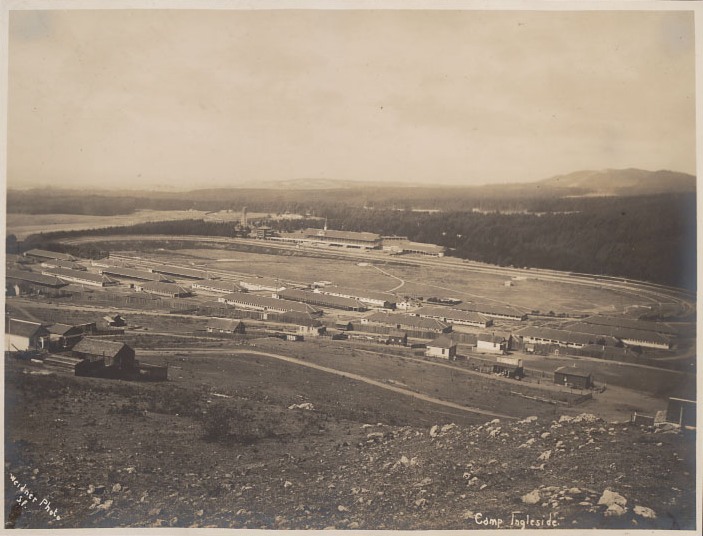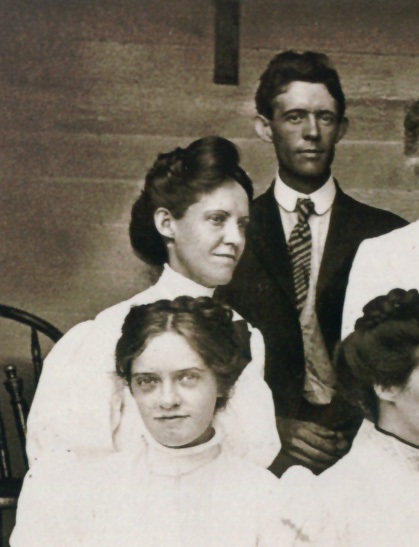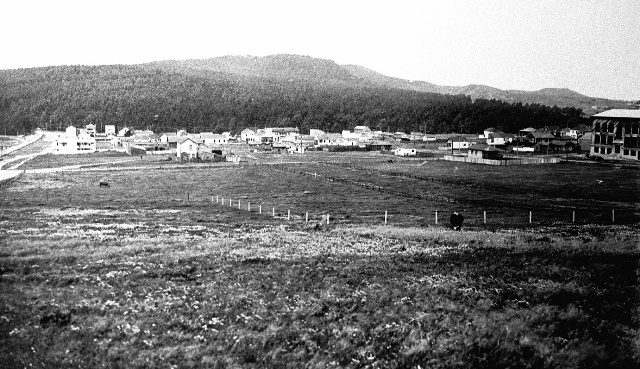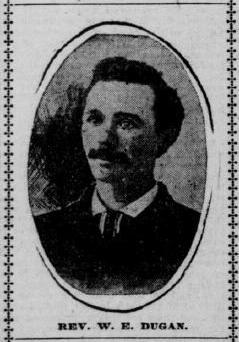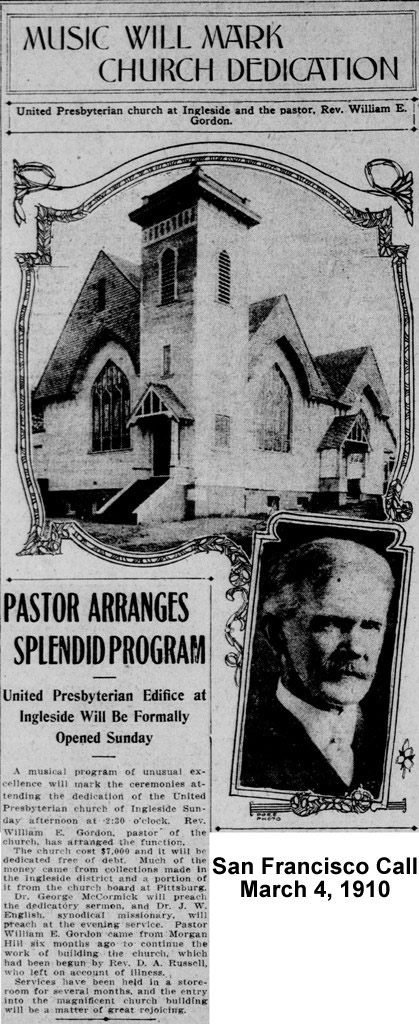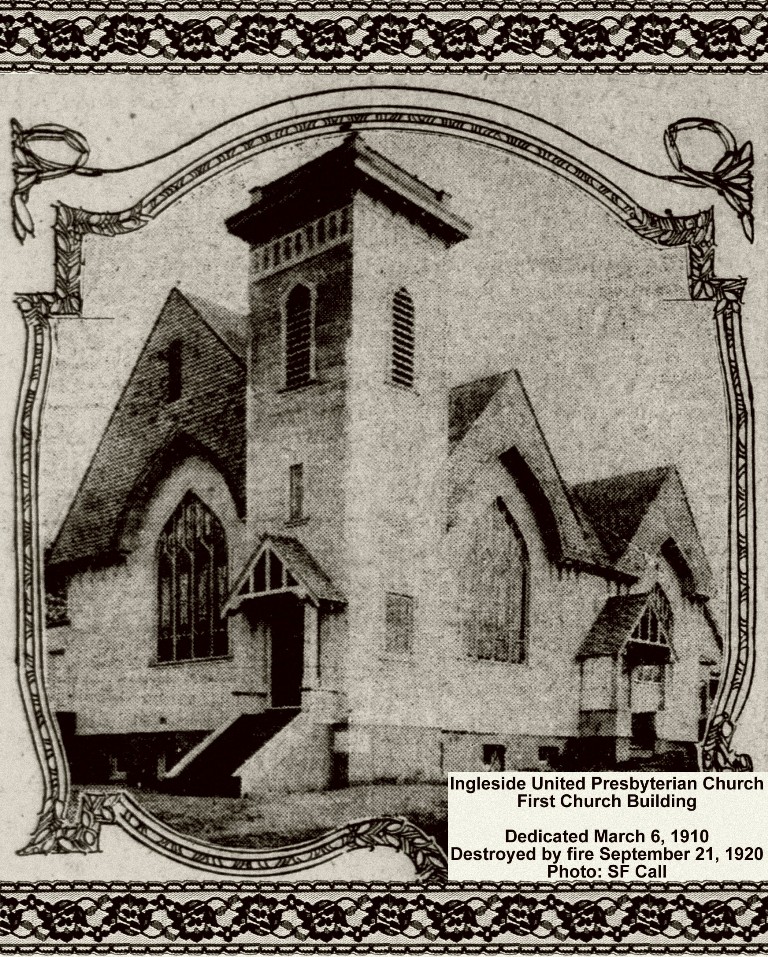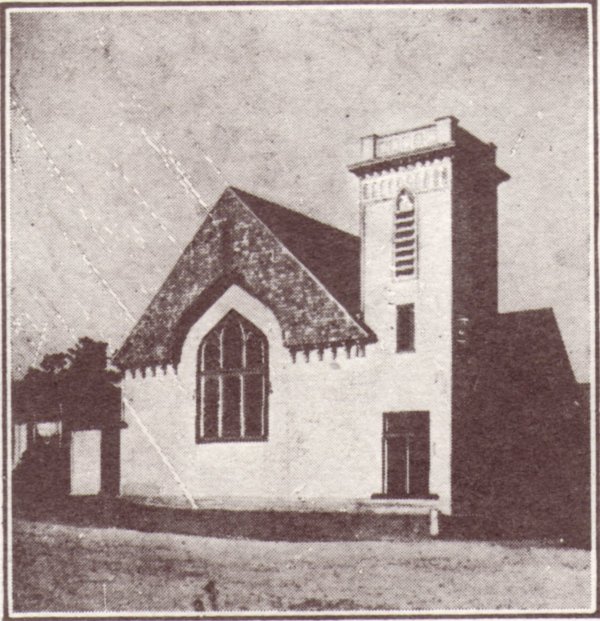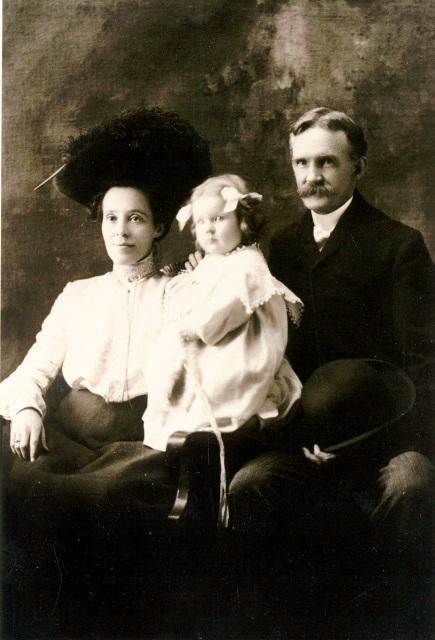The History of Ingleside Presbyterian Church
Ingleside Pre-Earthquake
The beginnings of Ingleside Presbyterian Church can be tied directly to the Great Earthquake and Fire of 1906.
Prior to the quake, the area now known as Ingleside was covered with Italian and Chinese vegetable farms which grew much of the produce used in downtown restaurants. The suburb of Ocean View sat on the other side of the hill to the South. To the North was Mt. Davidson, covered with the man-made Sutro Forest. To the West was the less than reputable Ingleside Racetrack. Ocean Avenue, the only thing that could pass for a road, was lined with pool halls, road houses, and gambling joints. In old San Francisco legends, the Ingleside seems to be a place where Barbary Coast gangs could run businesses without being bothered by the San Francisco Police Department.
Ingleside Sabbath School (1907-1910)
After the earthquake, the Ingleside Racetrack became a refugee camp, with the horse stables being converted to living quarters. Ingleside was the most remote of the camps, and was also one of the longest running camps. As other camps around the city were closed, the families that couldn't afford to rebuild were shuffled to Ingleside. This created a scenario where many of the poorest families in San Francisco ultimately ended up in the Ingleside by 1907.
Camp Ingleside, Believed to be Missionary Laura Sawhill (center), Ingleside in 1910 from Jules/Lakeview, Rev. W.E. Dugan, Robinson Hall (now apartments)
It was in this environment that Ingleside Presbyterian Church had its beginnings. Rev. W.E. Dugan assisted by Missionary Laura Sawhill, both of the old 2nd United Presbyterian Church in the Mission District organized the "Ingleside Sabbath School" on June 24th, 1907 to serve the refugees and small neighborhood that was beginning to grow up around the camp.
The Sabbath School met in the basement of the "Robinson Apartments" just outside of the refugee camp. Rev. Dugan would make the long trip from the Mission District to Ingleside in order to preach on Sunday afternoons. In 1908, the United Presbyterian Board installed Rev. D.A. Russell as Pastor of the church. Also in 1908, the United Presbyterian Board of Church Extension purchased lots at the corner of Ocean Avenue a few blocks to the East in order to build a suitable church building.
Ingleside Presbyterian Church Officially Organized
In January 1909, ground was broken on the new structure and the cornerstone was laid by Revs Dugan and Russell, along with Revs H.H. Bell and Rev. Paul Stewart. In March 1909, the cornerstone was laid by these same Pastors.
Work progressed, and Rev. W.E Gordon was installed as Pastor in 1909, when Rev. D.A. Russell became ill.
Ingleside's first building dedication, First building (drawing, 1910), First Building (photo), Rev. W.E. Gordon and family
On March 10th, 1910, the Ingleside United Presbyterian Congregation was formally organized with 39 charter members. Ingleside was the only church serving the population of around 2400. The new building was furnished with "camp chairs" and home made benches brought over from the Sabbath School. The congregation had truly humble beginnings, as it consisted of the poorest of the earthquake refugees, who had lost everything and many of whom purchased land on credit and were building homes one room at a time. During this time, and even for decades to come, 2nd United Presbyterian Church and W.E. Dugan provided critical assistance to Ingleside.
Tragedy Strikes A Growing Church
Rev. W.R. McKnight
In 1912, Rev. W.R. McKnight was installed as Pastor. Under Rev. McKnight, Ingleside built a Gymnasium in 1914 as a place for the community youth to avoid the influence of the pool halls and disreputable businesses that still lined Ocean Avenue. It was really under Rev. McKnight that Ingleside started its long history of focusing on community service in addition to Sunday worship.
In 1920, as many improvements were being made, tragedy struck as the church building was destroyed by fire. The fire was caused by a soldering pot being used to add electric lights to the building. In 1920, Ingleside was still too remote for a fire department to reach easily and a large crowd stood by helplessly as the building burned to the ground.
Rebuilding A Community Church
The fire only served to inspire the congregation to rebuild in a bigger and better way. The Ingleside and "West of Twin Peaks" neighborhoods were beginning to grow rapidly, and under the direction of Rev. McKnight, and with the assistance of Dr. J.W. English, Synodical Superintendent of Missions, plans were devised for a radically different kind of church building. The new church building would house 9 Protestant congregations, and would also include a "community service center". The United Presbyterian Mission and Church Building Board offered $25,000 provided that the community would provide a similar amount. Ingleside Presbyterian along with the eight other congregations raised the money and met the challenge. Much of the money came from donations from the community who were in great need of the community service center.
The new building was to be built by renowned "Arts and Crafts" architect, Joseph Leonard, who had designed many of the finest homes in the Bay Area, including those in Ingleside Terraces, which had been built on the site of the old Ingleside Racetrack. It appears that Leonard, who lived in Ingleside Terraces, may have come out of retirement to design and build what was going to be called "Ingleside Community Church".
Rev. A.E. Kelly
As work progressed on the new building, church services were held in a tent across the street. In 1921, Rev. A.E. Kelly was installed as Pastor. Rev. McKnight continued to serve as assistant Pastor until the new building was completed and then retired after having served more than 10 years. He continued to attend Ingleside long after his retirement, where he was venerated by the congregation and community. Rev. McKnight's spirit of community service was continued by Rev. Kelly, who was noted in a newspaper article at the time for choosing gymnasium equipment for the youth over a pipe organ for the sanctuary when money was tight.
The building was completed in 1923 and a San Francisco Examiner article at the time hailed what it called the "Ingleside Community Temple of God" as a religious milestone.
SF Examiner Article - 1923
The 1920s and 1930s
Ingleside Presbyterian - approx. 1923
Soon after the new building was completed, however, a recession struck, which left the church saddled with debt. Better transportation was also completed, which allowed many who had moved to Ingleside to attend their former downtown churches. Some of the congregations that were sharing the building moved out as they built their own buildings. Rev. A.E. Kelly resigned in 1926.
Rev. R.H. Gordon became Pastor in 1926 and immediately set to work helping the children of the neighborhood by organizing "after school" clubs which filled the church with children during the afternoons and evenings. This led to a brief period of revival, which saw increased support for the church and community center. Of course, the Great Depression struck in 1929, and Rev. Gordon was forced to resign due to ill health, leaving the church without a Pastor. Rev. Stanley Morrison Served as Interim Pastor following Rev. Gordon's departure.
During the early years of the Depression, an experiment was attempted by which the two largest national Presbyterian denominations, being the United Presbyterian Church and Presbyterian Church USA would have oversight over a federated church, which would have 2 congregations, one from each denomination sharing a Pastor, but with separate membership rolls. Up until this point, Ingleside had still not become financially independent and this agreement appears to have been done for financial reasons. In 1931, Rev. Herrick Lane, of the Presbyterian Church USA was assigned as Pastor over the federated congregation. Ultimately, the experiment failed, and the federation was dissolved in 1934, with Rev. Lane continuing as Pastor until 1935.
In 1935, Rev. John Alvin Campbell was assigned to Ingleside Presbyterian by the Board of American Missions and served until 1937. During this time, attempts were made to relocate the church to a smaller building, but without success. Rev. David S. Sharp was assigned to replace Rev. Campbell in 1937 and he continued until 1940. Overall the 30s appear to have been a tough decade for Ingleside Presbyterian, as it had to rely on financial assistance from the national denomination and other churches, such as 2nd United Presbyterian.
World War II Era
Rev. Peter McCormack
In 1940, however, a milestone was reached as Rev. Peter McCormack became the first called Pastor of Ingleside Presbyterian. This means that he was the first Pastor that wasn't assigned to the church by whatever denominational board was funding the church at the time. Ingleside was able to improve its financial standing as the United Presbyterian Board of American Missions absolved the church of its long standing debt, which led to Ingleside finally becoming self-supporting after 35 years of relying on assistance from Missionary boards. Under the leadership of Rev. McCormack, Ingleside saw another revival as church membership increased to well over 200 members. Ingleside lost many of its young men in World War II, but the congregation seems to have thrived both during and after the war. After serving for 12 years, Rev. McCormack sensed that the church was ready for new leadership and retired in 1952. Following Rev. McCormack's departure, Rev. G. Raymond White served as interim Pastor.
1950s and 1960s
Rev. Dwight White
The 50s appear to have been somewhat of a "golden period" for Ingleside Presbyterian. Under Rev. Dwight A White, who served from 1953 to 1957, many improvements to the building were made, such as a complete remodeling of the sanctuary, rewiring and remodeling of the gym and the building of the current Pastor's study. Weekly worship attendance increased to an average of 130 at this time. Following Rev. White's departure in 1957, Rev. Claire E. Hawthorne served as interim Pastor.
Ingleside on a rare snowy day in 1958
Rev. Albert Damon served Ingleside from 1958 to 1964, and Ingleside Presbyterian began to become a multiracial congregation. Under Rev. Damon, more improvements were made to the church building, including the installation of the large cross behind the choir loft, and the building of a chapel along Ocean Avenue, which later became the community center offices and elevator. At this time, the congregation also welcomed many new families into the community by inviting all racial groups to become active in the church program. A high-point of this effort was the sponsorship of two families from overseas.
Ingleside 60th Anniversary. Revs. Damon and Washburn pictured.
Rev. Charles H. Washburn became Pastor in 1964 and creatively filled the pastorate by beginning many new programs, such as the Ingleside Senior Center and Child Observation Center. By the early 70s, however, membership was dwindling as more and more families moved to the suburbs, and many of the families that had been moving to Ingleside from the Fillmore continued to attend church in their former neighborhood, which many still do today. In 1972, an African American Pastor, Rev. Alvin Mills was called as a co-pastor. Disagreement between the two pastors ultimately led to Rev. Washburn's departure and divided the congregation. Rev. Mills continued to serve until 1974.
The late 1960s and early 1970s - A Neighborhood In Transition
Ingleside Sunday School - 1966
During the late 60s and 70s, the Ingleside neighborhood underwent a dramatic demographic shift. Many of the families that had lived in Ingleside moved to the new suburbs that were sprouting up around the Bay. During this time, San Francisco lost nearly half of its residents to the suburbs. As Ingleside emptied, it became a refugee area again, but this time it wasn't because of an earthquake. The new refugees were fleeing from the redevelopment of the Fillmore District, which had been San Francisco's historic African American neighborhood. At the time, much of San Francisco was effectively closed off to non-Whites, with Ingleside being one of the few neighborhoods where these families could move.
The Late 1970s - A Church In Trouble
By 1974, the Ingleside Presbyterian was really in dire straights. The neighborhood had become a low-rent district with high vacancy rates, and nearly 1/3 of the houses were managed by absentee landlords. Rev. Byron Bland, a recent seminary graduate was called into a nearly impossible situation. The church's ability to stay financially solvent depended almost entirely on rental income from City College of San Francisco. Rev. Bland helped to stabilize the situation, but church membership had dwindled to the point where there were only 10 members present at the annual congregational meeting in 1976. Rev. Bland sought to minister to the community whether or not it would increase the church rolls.
After Rev. Bland departed in 1976 to become chaplain at Stanford University, Ingleside could no longer afford to call another Pastor. Rev. Lionel Cable, and Rev. George Briggs served as interim Pastors, being paid weekly for their services. Other pastors were hired on a weekly basis to preach on Sunday to keep worship services going. By 1978, Ingleside was down to 4 members.
Ingleside was facing imminent closure. Rumors were that the building had been put up for sale. Interim Pastor Rev. Claude Kilgore and Clerk of the Session Dorcas Thomas argued for and received more time to try to save the congregation. In late 1978, with no money to pay a Pastor, Rev. Kilgore recommended to the congregation that they hire a first year seminary student, named Roland Gordon to preach on Sundays for a weekly salary of fifty dollars ($50.00).
Revitalization
Rev. Roland Gordan
The Session adopted Rev. Gordon's visionary philosophy of "Service to God through service to Humanity". Rev. Gordon brought a new level of rugged determination and faith to the struggling Ingleside Church Family. Roland has stated, that because of this life's experience of struggle with seemingly impossible situations, he had grown to believe the Word, "With God, all things are possible". He immediately understood the Ingleside situation as an opportunity for God to be glorified by His powerful movement through this small remnant, which had essentially nothing to hold on to, but faith.
Rev. Gordon's strategy was as follows:
- To reassure the four active supports that "God Never Fails". We fail, but God never fails. For with God, "all things are possible", if we believe and act on our belief.
- To adopt a church motto, (II Corinthians 5:7) "We Walk by Faith, Not by Sight".
- To launch a fund raising campaign to paint the outside of the building. This gave the Church an immediate goal. Since most people measure progress by what they see, the painting of the building was a crucial project.
- To seek a core group congregation on which to build and from which to draw more elders and officers.
The congregation and community activities began to grow. By the middle of 1982, our membership had grown considerably in both active and support members. A highpoint around this time was the Diamond Jubilee, 75th Anniversary Celebration, which occurred on June 27th, 1982. A number of outstanding persons received the "Ingleside Diamond Jubilee Award".
July 31, 1983 was another important date, as many outstanding persons from our Presbytery and from across the country, joined in celebrating the ordination of our now full-time Pastor, Rev. Roland Gordon. We must applaud Rev. Bert Tom and the Racial Ethnic Ministries Committee of the San Francisco Presbytery, the Presbytery and National Church for the important role they played in support of our redevelopment ministry.
To better serve the community, Rev. G. founded the Ingleside Community Center in September of 1986, with the assistance of Elders Carieta Cain and Earline Furlough. Elder Cain was hired as the community center's first Executive Director of this important community service ministry. Rev. Cain moved on to full time pastoral ministry and was succeeded by Gilbert Gordon and then Monique Martin, who expanded the many services to community youths and adults.
In response to an overture passed by the Presbyterian General Assembly, declaring African American males "An Endangered Species," Rev. Gordon founded the Thad Brown Boys Academy in the fall of 1998. The vision is to develop a core group to be leaders and role models for their peers, and ultimately help other boys grow to become productive citizens. Academic, tutorial, mentoring, computer, social skills and leadership development are key emphasis of the academy. In collaboration with the support of the San Francisco Unified School District the academy has helped numerous boys to succeed in life. The Executive Directors of this project over the years include Robert Tealer, Rev. Reginald Nichols, and Stephanie Simms.
Rev. Gordon, including the boys from the academy, headed up a project to clean up an eyesore in the community, the "Phelan Loop." With the help of the Director of the Mayor's Beautification Fund, Wendy Nelder, a major clean up of the area transpired with the community and many city Departments also assisting. Upon completion of the project, "MUNI" provided a grant used to plant a lawn, flowers and sixteen palm trees. The area was named, The Leonard "Lefty" Gordon World Peace Memorial Garden, and a critical message was installed in large white letters on the hillside, "LOVE IS THE ANSWER." The bus passenger seating area was enclosed and Rev. G assisted by Elder Paula Bibbs opened the ICC/Don Chee Loop Café to provide jobs and business experience for neighborhood youth.
In January 2001, a Lilly Endowment funded nationwide study of local Church excellence identified Ingleside Presbyterian Church among the top three hundred outstanding Protestant Churches in the United States. The study looked for churches that nurtured the spirit, welcomed and yet challenged; both preached and more importantly, lived the "Good News". The study also looked for churches that not only take care of their members and the newcomer, but also reach out generously to the world. Rev. Gordon was also honored by the San Francisco Theological Seminary in 2003, as the "Distinguished Alumni", and Rev. Gordon's Alma Mater, Baldwin Wallace College selected him as the 2004 Alumni Merit Awardee.
We are also proud of the three ordained clergy our rebuilding ministry has spawned, the Rev. Carieta Cain-Grizzell, Rev. Dr. Lorenzo Carlisle, and the Rev. Dr. Charles Tinsley.
It is also noteworthy that Rev. G has for over 27 years been developing a collage/mural, "The Great Cloud of Witnesses", which is believed to be the largest most extensive work of its kind anywhere. It features African American History and is referred to by former Mayor Willie L. Brown as Rev. G.'s "great legacy to the City of San Francisco."
Great Cloud of Witnesses
A spirit of family exists among the many persons of all races and backgrounds who frequent our programs and attend church services. There is truly something special about Ingleside Presbyterian Church: "The Lord is building this house" (Psalm 127:1).
The church cornerstone reveals the mindset:
Thanks to Woody Labounty at Western Neighborhood Project for allowing us to use historic images from the WNP Website (www.oustidelands.org). Thanks also to the Gordon, Fussmann, Damon, and Washburn families for providing photos from their collections.

